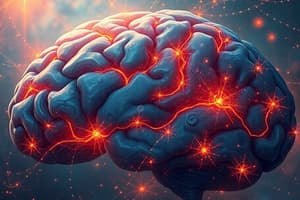Podcast
Questions and Answers
The multi-store model of memory was devised by ______ and Shiffrin in 1968.
The multi-store model of memory was devised by ______ and Shiffrin in 1968.
Atkinson
The sensory register is the first system in the ______ model of memory.
The sensory register is the first system in the ______ model of memory.
MSM
Information enters the sensory register coded in a raw and unfiltered format via ______ organs.
Information enters the sensory register coded in a raw and unfiltered format via ______ organs.
sense
The iconic store retains visual data for around ______ milliseconds.
The iconic store retains visual data for around ______ milliseconds.
Short-term memory is sometimes referred to as ______ memory within the working memory model.
Short-term memory is sometimes referred to as ______ memory within the working memory model.
Research suggests that short-term memory has a capacity for between ______ and 9 items.
Research suggests that short-term memory has a capacity for between ______ and 9 items.
Most information that passes through the sensory register is very quickly ______.
Most information that passes through the sensory register is very quickly ______.
Information that catches attention in the sensory register is passed on to ______ memory.
Information that catches attention in the sensory register is passed on to ______ memory.
According to Deffenbacher, a moderate amount of ______ produces the most accurate eyewitness testimony.
According to Deffenbacher, a moderate amount of ______ produces the most accurate eyewitness testimony.
Christianson and Hubinette's research on bank robberies found no relationship between ______ and accuracy of testimony.
Christianson and Hubinette's research on bank robberies found no relationship between ______ and accuracy of testimony.
The ______ is a method used to improve the accuracy of eyewitness testimony during police interviews.
The ______ is a method used to improve the accuracy of eyewitness testimony during police interviews.
One of the key elements of the cognitive interview is ______ reinstatement, which helps trigger memories.
One of the key elements of the cognitive interview is ______ reinstatement, which helps trigger memories.
Loftus et al. found that when a weapon is involved, witnesses focus more on the ______ rather than other details.
Loftus et al. found that when a weapon is involved, witnesses focus more on the ______ rather than other details.
Milne and Bull discovered that ______ and reporting everything are the most crucial features of the cognitive interview.
Milne and Bull discovered that ______ and reporting everything are the most crucial features of the cognitive interview.
The ______ cognitive interview includes asking open-ended questions and not interrupting the witness.
The ______ cognitive interview includes asking open-ended questions and not interrupting the witness.
Deffenbacher's meta-analysis indicated that high levels of ______ negatively affect eyewitness testimony.
Deffenbacher's meta-analysis indicated that high levels of ______ negatively affect eyewitness testimony.
The inverted-U hypothesis posits that too much or too little ______ reduces the accuracy of eyewitness testimony.
The inverted-U hypothesis posits that too much or too little ______ reduces the accuracy of eyewitness testimony.
Using different perspectives during recall can help reduce the effect of the witness’s ______.
Using different perspectives during recall can help reduce the effect of the witness’s ______.
Procedural memory is considered to be ______.
Procedural memory is considered to be ______.
Patients with retrograde amnesia may forget ______ details of their lives.
Patients with retrograde amnesia may forget ______ details of their lives.
Semantic memory seems to originate within ______ memory.
Semantic memory seems to originate within ______ memory.
Forgetting can be explained by ______ and retrieval failure.
Forgetting can be explained by ______ and retrieval failure.
Proactive interference occurs when older information interferes with ______ information.
Proactive interference occurs when older information interferes with ______ information.
Retroactive interference is when newer information disrupts ______ information.
Retroactive interference is when newer information disrupts ______ information.
Context-dependent failure occurs when the external environment does not provide the necessary ______ to recall a memory.
Context-dependent failure occurs when the external environment does not provide the necessary ______ to recall a memory.
State-dependent failure refers to differences in the internal environment between the time of ______ and the time of recall.
State-dependent failure refers to differences in the internal environment between the time of ______ and the time of recall.
Eyewitness testimony can be considered ______ due to various influencing factors.
Eyewitness testimony can be considered ______ due to various influencing factors.
Participants could remember an average of 7 letters and 9 ______.
Participants could remember an average of 7 letters and 9 ______.
The study by Loftus and Palmer involved participants watching ______ clips of car crashes.
The study by Loftus and Palmer involved participants watching ______ clips of car crashes.
The method of grouping items into semantically similar groups is called ______.
The method of grouping items into semantically similar groups is called ______.
Participants were asked how fast cars were going using different ______ in their questions.
Participants were asked how fast cars were going using different ______ in their questions.
Short-term memory can last for about ______ seconds.
Short-term memory can last for about ______ seconds.
Extended rehearsal can transfer information from short-term memory to ______.
Extended rehearsal can transfer information from short-term memory to ______.
After being asked leading questions, participants estimated a ______ speed.
After being asked leading questions, participants estimated a ______ speed.
The duration of long-term memory can potentially last for a ______.
The duration of long-term memory can potentially last for a ______.
Leading questions can add ______ information to a memory.
Leading questions can add ______ information to a memory.
During an experiment, participants were shown a video and asked about a ______ that was not present.
During an experiment, participants were shown a video and asked about a ______ that was not present.
Memories are often forgotten due to deterioration or ______.
Memories are often forgotten due to deterioration or ______.
Bahrick et al (1975) found that participants could remember 70% of faces after ______ years.
Bahrick et al (1975) found that participants could remember 70% of faces after ______ years.
The multi-store model suggests separate memory stores for sensory register, short-term memory, and ______.
The multi-store model suggests separate memory stores for sensory register, short-term memory, and ______.
Anterograde amnesia affects the ability to store ______.
Anterograde amnesia affects the ability to store ______.
In the working memory model, the central executive filters and coordinates various ______.
In the working memory model, the central executive filters and coordinates various ______.
The WMM divides short-term memory into four components: the central executive, phonological loop, visuo-spatial sketchpad, and the ______.
The WMM divides short-term memory into four components: the central executive, phonological loop, visuo-spatial sketchpad, and the ______.
The capacity of the central executive is relatively ______.
The capacity of the central executive is relatively ______.
According to Baddeley (1996), participants struggled to perform two tasks due to competition for central executive ______.
According to Baddeley (1996), participants struggled to perform two tasks due to competition for central executive ______.
The ______ model of memory provides a more detailed understanding compared to the multi-store model.
The ______ model of memory provides a more detailed understanding compared to the multi-store model.
The visuo-spatial sketchpad is often described as the mind's inner ______.
The visuo-spatial sketchpad is often described as the mind's inner ______.
The component responsible for switching attention to specific information sources is known as the central ______.
The component responsible for switching attention to specific information sources is known as the central ______.
The phonological loop processes information coded in ______ format.
The phonological loop processes information coded in ______ format.
The phonological store is sometimes referred to as the inner ______.
The phonological store is sometimes referred to as the inner ______.
Words that are longer are more challenging to store in the phonological ______.
Words that are longer are more challenging to store in the phonological ______.
The episodic buffer serves as a temporary ______ for information coded in various formats.
The episodic buffer serves as a temporary ______ for information coded in various formats.
Research suggests that there are different types of long-term memory, primarily ______ and implicit.
Research suggests that there are different types of long-term memory, primarily ______ and implicit.
Episodic long-term memory includes memories of specific ______ and the context in which they happened.
Episodic long-term memory includes memories of specific ______ and the context in which they happened.
Semantic long-term memory is focused on ______, understanding, and general knowledge.
Semantic long-term memory is focused on ______, understanding, and general knowledge.
Procedural long-term memory involves knowing how to carry out ______ and skills.
Procedural long-term memory involves knowing how to carry out ______ and skills.
The articulatory loop is responsible for ______ words to keep them in the phonological loop.
The articulatory loop is responsible for ______ words to keep them in the phonological loop.
Studies have shown that short-term recall of words is better when learned ______.
Studies have shown that short-term recall of words is better when learned ______.
The visuo-spatial sketchpad allows the storage of ______ and spatial information.
The visuo-spatial sketchpad allows the storage of ______ and spatial information.
Miyake et al (2000) found differences in the capacity for executive tasks, suggesting the central executive has ______ parts.
Miyake et al (2000) found differences in the capacity for executive tasks, suggesting the central executive has ______ parts.
Strong emotions can lead to more robust coding of episodic ______.
Strong emotions can lead to more robust coding of episodic ______.
Flashcards
Sensory Register
Sensory Register
The first stage of memory, where raw sensory information is briefly stored.
Coding
Coding
The way information is processed and stored in memory, such as visually or acoustically.
Capacity
Capacity
The amount of information that can be held in a memory store.
Duration
Duration
Signup and view all the flashcards
Short-term Memory
Short-term Memory
Signup and view all the flashcards
Magical Number 7
Magical Number 7
Signup and view all the flashcards
Rehearsal
Rehearsal
Signup and view all the flashcards
Long-term Memory
Long-term Memory
Signup and view all the flashcards
Chunking
Chunking
Signup and view all the flashcards
Retrieval
Retrieval
Signup and view all the flashcards
Multi-store model of memory
Multi-store model of memory
Signup and view all the flashcards
Central executive
Central executive
Signup and view all the flashcards
Phonological loop
Phonological loop
Signup and view all the flashcards
Visuo-spatial sketchpad
Visuo-spatial sketchpad
Signup and view all the flashcards
Episodic buffer
Episodic buffer
Signup and view all the flashcards
Anterograde amnesia
Anterograde amnesia
Signup and view all the flashcards
Retrograde amnesia
Retrograde amnesia
Signup and view all the flashcards
Working memory model
Working memory model
Signup and view all the flashcards
Cognitive flexibility
Cognitive flexibility
Signup and view all the flashcards
Inverted-U Hypothesis
Inverted-U Hypothesis
Signup and view all the flashcards
Weapons Effect
Weapons Effect
Signup and view all the flashcards
Cognitive Interview
Cognitive Interview
Signup and view all the flashcards
Context Reinstatement
Context Reinstatement
Signup and view all the flashcards
Recall from Different Perspectives
Recall from Different Perspectives
Signup and view all the flashcards
Recall in Different Chronological Order
Recall in Different Chronological Order
Signup and view all the flashcards
Report Everything
Report Everything
Signup and view all the flashcards
Meta-Analysis
Meta-Analysis
Signup and view all the flashcards
Enhanced Cognitive Interview
Enhanced Cognitive Interview
Signup and view all the flashcards
Memory Recall
Memory Recall
Signup and view all the flashcards
What is the central executive in the working memory model?
What is the central executive in the working memory model?
Signup and view all the flashcards
What is the visuo-spatial sketchpad?
What is the visuo-spatial sketchpad?
Signup and view all the flashcards
What is the phonological loop?
What is the phonological loop?
Signup and view all the flashcards
What is the phonological store?
What is the phonological store?
Signup and view all the flashcards
What is the articulatory loop?
What is the articulatory loop?
Signup and view all the flashcards
What is the episodic buffer?
What is the episodic buffer?
Signup and view all the flashcards
What is the core idea of the working memory model?
What is the core idea of the working memory model?
Signup and view all the flashcards
What evidence supports the separate components of the working memory model?
What evidence supports the separate components of the working memory model?
Signup and view all the flashcards
What brain imaging evidence supports the working memory model?
What brain imaging evidence supports the working memory model?
Signup and view all the flashcards
What are some criticisms of the working memory model?
What are some criticisms of the working memory model?
Signup and view all the flashcards
What is the basic idea behind the different types of long-term memory?
What is the basic idea behind the different types of long-term memory?
Signup and view all the flashcards
What is explicit long-term memory?
What is explicit long-term memory?
Signup and view all the flashcards
What is implicit long-term memory?
What is implicit long-term memory?
Signup and view all the flashcards
What is episodic long-term memory?
What is episodic long-term memory?
Signup and view all the flashcards
What is semantic long-term memory?
What is semantic long-term memory?
Signup and view all the flashcards
What is procedural memory?
What is procedural memory?
Signup and view all the flashcards
What is explicit memory?
What is explicit memory?
Signup and view all the flashcards
What is implicit memory?
What is implicit memory?
Signup and view all the flashcards
What is semantic memory?
What is semantic memory?
Signup and view all the flashcards
What is episodic memory?
What is episodic memory?
Signup and view all the flashcards
What is proactive interference?
What is proactive interference?
Signup and view all the flashcards
What is retroactive interference?
What is retroactive interference?
Signup and view all the flashcards
What is retrieval failure due to absence of cues?
What is retrieval failure due to absence of cues?
Signup and view all the flashcards
What is context-dependent failure?
What is context-dependent failure?
Signup and view all the flashcards
What is state-dependent failure?
What is state-dependent failure?
Signup and view all the flashcards
What is misleading information in eyewitness testimony?
What is misleading information in eyewitness testimony?
Signup and view all the flashcards
What are leading questions in eyewitness testimony?
What are leading questions in eyewitness testimony?
Signup and view all the flashcards
What is false information in eyewitness testimony?
What is false information in eyewitness testimony?
Signup and view all the flashcards
Why is eyewitness testimony sometimes unreliable?
Why is eyewitness testimony sometimes unreliable?
Signup and view all the flashcards
Why is research into eyewitness testimony important?
Why is research into eyewitness testimony important?
Signup and view all the flashcards
Study Notes
Multi-Store Model (MSM)
- Proposed by Atkinson and Shiffrin (1968)
- Explains memory as information flowing through three stores: sensory register, short-term memory, and long-term memory.
- Each store has different characteristics: coding, capacity, and duration.
Sensory Register
- Initial memory system receiving sensory input.
- Information is raw and unfiltered, entering via senses.
- Includes iconic store (visual) and echoic store (auditory).
- Large capacity, but fleeting duration (e.g., iconic store: 500ms, echoic store: 2 seconds).
- Retained if attended to, moving to short-term memory.
Short-Term Memory (STM)
- Holds information currently being processed.
- Receives selected information from the sensory register and codes it (visual, acoustic, semantic).
- Capacity limited (7 ± 2 items).
- Increased by chunking (grouping items).
- Duration of ~30 seconds but can be extended through rehearsal.
- Rehearsal transfers info to long-term memory (LTM).
Long-Term Memory (LTM)
- Stores information for long durations (potentially a lifetime).
- Includes many types of memory.
- Coding format flexible (visual, acoustic, semantic, olfactive).
- Very large capacity.
- Forgetting from LTM is due to decay or interference.
- Retrieval of LTM transfers information to STM.
Working Memory Model (WMM)
- Developed by Baddeley and Hitch (1974).
- Builds on MSM, especially the STM component.
- Divides STM into four components.
WMM Components
- Central Executive: Controls and coordinates other components, limited capacity.
- Phonological Loop: Processes auditory information (inner ear and inner voice). Limited by word length.
- Visuo-Spatial Sketchpad: Stores visual and spatial information (mental images).
- Episodic Buffer: Temporary storage integrating information from different components.
Types of Long-Term Memory
- Explicit (Declarative): Consciously recalled; includes:
- Episodic: Personal experiences, details, context, and emotions.
- Semantic: General knowledge, facts, concepts.
- Implicit (Nondeclarative): Unconsciously recalled; includes:
- Procedural: Skills, actions, abilities.
Forgetting
- Interference: Information disrupts recall; can be retroactive (new disrupts old) or proactive (old disrupts new).
- Retrieval Failure: Inability to access stored information due to lack of cues.
- Context-Dependent: External environment during recall differs from encoding.
- State-Dependent: Internal state during recall differs from encoding.
Eyewitness Testimony
- Can be unreliable due to factors like misleading information and anxiety.
- Misleading Information: Leading questions or post-event discussions can alter memories.
- Anxiety: Moderate anxiety leads to better accuracy, while extreme anxiety impairs recall.
Improving Eyewitness Testimony: The Cognitive Interview
- Method to increase accuracy and detail in police interviews.
- Elements: Context reinstatement, recall from different perspectives, recall in different orders, report everything.
- Evidence suggests effectiveness, but some issues persist.
Strengths & Weaknesses of MSM & WMM
- MSM is initially influential, but conceptually oversimplified.
- WMM provides more detailed and nuanced view of short-term memory but is still potentially oversimplified.
Studying That Suits You
Use AI to generate personalized quizzes and flashcards to suit your learning preferences.




